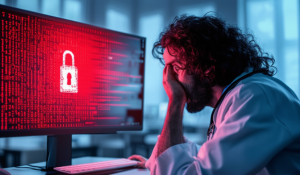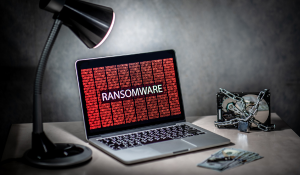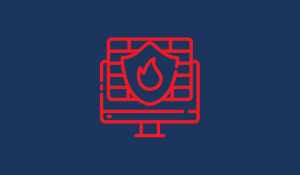Ransomware 101: A Comprehensive Guide to Defend Your Data and Systems
In today's rapidly evolving digital landscape, the menace of cyber threats looms larger than ever, with one particularly notorious adversary leading...

Cybersecurity is as essential as medical expertise. Ransomware attacks on healthcare systems are increasingly putting patient lives and sensitive data at risk. However, the rise of ransomware attacks has exposed vulnerabilities in healthcare systems, threatening not only data but also lives. These malicious attacks encrypt critical patient records, disrupt vital medical equipment, and force hospitals to halt operations, creating chaos in environments where every second counts.
This blog explores the far-reaching impacts of ransomware on healthcare systems, examining how these attacks jeopardize patient care, strain resources, and lead to devastating financial and reputational losses. Whether you’re a healthcare professional, IT specialist, or concerned patient, understanding the scale and severity of this issue is vital in the fight to secure the future of healthcare.
In recent years, ransomware attacks on healthcare systems have surged, posing severe risks to patient safety and data integrity. These cyberattacks, often orchestrated by highly sophisticated criminal groups, involve encrypting critical data and systems, rendering them unusable until a ransom is paid. Given the sensitive nature of healthcare information and the sector’s life-or-death urgency, hospitals, clinics, and other healthcare facilities have become prime targets for cybercriminals seeking to exploit vulnerabilities.
The heavy reliance of modern healthcare on digital systems amplifies this vulnerability. From electronic health records (EHRs) to diagnostic tools, scheduling systems, and even life-saving equipment, virtually every aspect of care depends on interconnected technology. A successful ransomware attack can bring these systems to a standstill, delaying treatments, compromising care, and putting patient lives in immediate jeopardy.
Moreover, as attackers adopt more advanced tactics, the frequency, scale, and sophistication of these incidents continue to rise. Double extortion schemes—where criminals threaten to release sensitive patient data if their ransom demands aren’t met—have become increasingly common, compounding the financial and reputational damage to healthcare organizations.
To combat this growing threat, healthcare institutions must adopt a proactive approach, combining robust cybersecurity measures, staff training, and system resilience planning to safeguard their operations and protect the patients who depend on them.
Ransomware attacks can bring hospital operations to a grinding halt. When critical systems are locked down, healthcare providers are unable to access patient records, administer treatments, or perform essential procedures. This not only delays patient care but can also lead to severe health complications and even fatalities.
Furthermore, the disruption extends beyond immediate patient care. Billing systems, appointment scheduling, and communication networks are often affected, causing widespread chaos and confusion. The inability to provide timely care can damage a hospital's reputation and erode patient trust.
Discover how ransomware attacks can severely compromise hospital cybersecurity, disrupting critical systems, endangering patient safety, and causing widespread operational and financial challenges:
1. Initial Infection: Ransomware infiltrates a hospital’s network, often through phishing emails, malicious links, or infected software updates. Attackers may exploit vulnerabilities in outdated systems or gain unauthorized access using stolen credentials.
2. Encryption of Data: Once inside the system, ransomware encrypts critical files and databases, rendering them inaccessible to hospital staff. These encrypted files often include:
Patient medical records (Electronic Health Records - EHR).
Appointment schedules.
Diagnostic imaging and test results.
3. Disruption of Medical Equipment: Many hospital devices, such as MRI machines, ventilators, and diagnostic tools, are connected to the hospital’s network. If these systems rely on affected servers or software, they can also become non-operational.
4. Operational Chaos:
Communication Breakdown: Staff can lose access to email systems, phone lines, or inter-departmental communication tools.
Manual Workarounds: Employees may revert to pen-and-paper methods, causing delays in treatments and diagnoses.
Rescheduled Procedures: Surgeries and other critical procedures may be postponed due to lack of access to patient data or functional medical systems.
5. Compromised Patient Safety: Ransomware can delay or prevent urgent medical interventions:
Incorrect or incomplete patient data may lead to errors in treatment.
Ambulances may need to redirect patients to unaffected hospitals, delaying critical care.
6. Financial and Reputational Damage:
Ransom Payments: Hospitals may feel pressured to pay the ransom to regain access to critical systems, especially in life-threatening situations.
Long-term Costs: Recovery efforts, legal fees, and potential fines for data breaches can be significant.
Trust Erosion: Patients may lose confidence in the hospital's ability to protect sensitive data.
The financial repercussions of ransomware attacks on healthcare systems are substantial. Hospitals may face hefty ransom demands, often running into millions of dollars. Even if the ransom is paid, the costs associated with system recovery, data restoration, and increased cybersecurity measures can be overwhelming.
Legal implications are also significant. Healthcare providers are bound by strict regulations to protect patient data. A ransomware breach can result in non-compliance with laws such as HIPAA, leading to fines, lawsuits, and long-term reputational damage. The legal fallout often extends to patient notifications, regulatory reporting, and potential litigation.
Ransomware attacks on hospitals can lead to severe and far-reaching consequences. Below is a detailed list of the potential outcomes, categorized into critical areas:
Operational Disruptions
System Downtime: Hospital systems such as electronic health records (EHRs), scheduling software, and diagnostic tools may become inaccessible, forcing staff to revert to manual processes.
Delayed Treatments: Without access to medical records or functioning equipment, patient care and emergency procedures can be delayed.
Rescheduled Appointments: Elective surgeries, diagnostics, and routine check-ups may need to be postponed.
Patient Safety Risks
Treatment Errors: Limited access to accurate patient data can lead to incorrect diagnoses or treatments.
Redirection of Emergencies: Ambulances may need to divert patients to unaffected facilities, delaying critical care.
Increased Mortality Rates: Life-threatening delays caused by disrupted systems can lead to preventable fatalities.
Reputational Damage
Erosion of Trust: Patients may lose confidence in a hospital's ability to safeguard sensitive data and deliver reliable care.
Negative Publicity: Media coverage of such incidents can tarnish the institution’s reputation, affecting patient retention and recruitment.
Compromised Data Integrity
Loss of Critical Records: Encrypted or stolen data may be permanently lost, affecting long-term patient care and research.
Double Extortion Risks: Attackers may threaten to leak sensitive patient data unless additional ransom payments are made.
Impact on Staff and Resources
Increased Stress: Employees face immense pressure to manage crises, often working long hours under chaotic conditions.
Staff Shortages: Prolonged disruptions may lead to employee dissatisfaction and turnover.
Resource Drain: Hospitals may need to redirect funds from patient care to address cybersecurity issues.
Long-term Consequences
Weakened Healthcare Systems: Repeated attacks can strain an institution’s financial and operational resources, making it less resilient to future threats.
Target for Future Attacks: A successful ransomware attack may encourage further attempts, as attackers view the institution as a lucrative target.
To mitigate the threat of ransomware, healthcare systems must adopt a proactive and comprehensive cybersecurity strategy that combines technology, training, and proactive planning.
First, hospitals and clinics should implement robust defenses, including advanced firewalls, intrusion detection systems, and endpoint protection solutions such as DriveLock's HYPERSECURE Endpoint Protection Platform to prevent unauthorized access. Regularly updating software and patching vulnerabilities is critical to minimizing exploitable weaknesses.
Second, staff training programs should focus on identifying phishing attempts, using strong passwords, and following cybersecurity best practices. Additionally, healthcare organizations must perform routine data backups and store them securely offline, ensuring rapid recovery in the event of an attack. Conducting regular security audits and penetration testing can also help identify and address potential risks.
Additionally, implementing multi-factor authentication (MFA) and conducting regular security audits can further bolster defenses.
Lastly, having a detailed incident response plan ensures hospitals can act quickly and effectively to minimize disruption and safeguard patient care during a ransomware attack. Investing in cybersecurity insurance and establishing a detailed incident response plan are also crucial steps in preparing for potential attacks.
While ransomware is a prominent threat, it is not the only cyber risk facing healthcare providers. Phishing attacks, where malicious actors attempt to steal sensitive information through deceptive emails, remain a common and effective tactic.
Distributed Denial of Service (DDoS) attacks can overwhelm hospital networks, causing significant downtime. Insider threats, whether from disgruntled employees or unintentional errors, also pose substantial risks. Additionally, vulnerabilities in medical devices connected to the Internet of Things (IoT) can be exploited to gain unauthorized access to critical systems. Addressing these varied threats requires a multi-layered security approach and continuous vigilance.
Ransomware poses a profound threat to hospitals, with the potential to cripple operations, compromise patient safety, and erode trust in healthcare systems. As these attacks grow more sophisticated and widespread, the need for robust cybersecurity measures has never been more urgent. Hospitals must prioritize investing in advanced defenses, staff training, and contingency planning to protect their systems and patients.
The healthcare sector can reduce the impact of ransomware and continue to provide the essential care that communities rely on. Ransomware may be a formidable challenge, but with the right strategies, hospitals can safeguard their operations and the lives they are entrusted to protect.

In today's rapidly evolving digital landscape, the menace of cyber threats looms larger than ever, with one particularly notorious adversary leading...

Are you ready to fortify your digital defenses and safeguard your network from cyberattacks? Look no further than the network firewall. A formidable...

As organizations embark on their digital transformation journey, endpoint security has become a defining element of business success, and its...